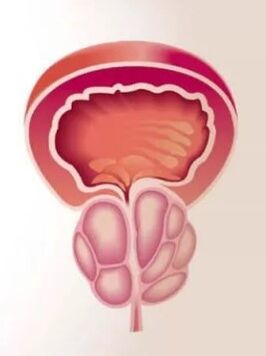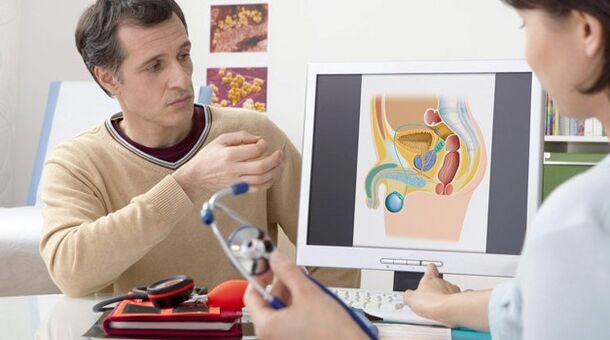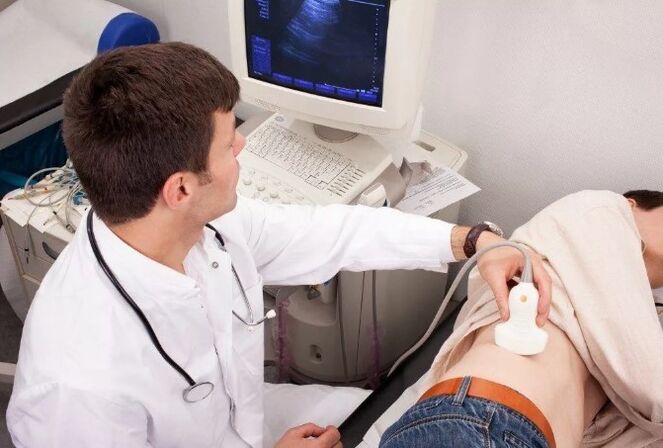Prostatitis is the most common urology pathology in males of reproductive age. According to polls, they experience symptoms at least every third of their lives, which can be explained as inflammation of the prostate. Despite such a high incidence of pathology, prostatitis is still a well-studied disease.Until today, there is no consensus that it becomes the starting factor for inflammation, as in only 10% of cases, the pathogen of STI can be distinguished from the urogenital tract of the patient.

The lack of clear diagnostic criteria and signs of the disease complicates the patient's accounting. The symptoms of prostatitis are so nonspecific that every doctor explains them with great subjectivity and attributes them to completely different pathology. Therefore, treatments are different, and often linger from a hospital cabinet, without any positive dynamics over the years. Prostatitis deprives a person of confidence in his sexual power, hangs up his thoughts on a problem, and brings him physically worse than psychological emotional pain.
What is the prostate and why do you need it?
The prostate (prostate) is a small gland organ located around the urethra below the bladder. It beats the urethra tightly, forming one of its sphincters – a muscle socket designed to hold urine. The form and size of the prostate is similar to a chestnut nut, which is usually compared to an anatomist. A part of the urethra passes through the inside of the glands and is called the prostate. The kyphosis of its prostate is in contact with the rectum, so it can be easily felt by checking the rectal fingers. The anterior surface of the gland is close to the pubic junction and is connected to the ligaments of the connecting tissue, with the venous plexus located between them.
The prostate is composed of lobes, each of which is made of alveolar-small bags lined with small bags that secrete epithelium. The alveoli are connected to the outlet tube, and the forms of the tubes are fused to each other, merge with each other, enlarge and eventually fall into a simple part of the urethra. In the secretory bag, prostate juice is synthesized and accumulated, including nutrients for sperm. It allows male sexual cells to maintain their activity in women for up to 5 days, significantly increasing the chance of fertilization.
The enlightenment of the gland occurs when ejaculation occurs. The secret mix of prostate juice with the testicles makes up 10 to 30% of the final volume of sperm. therefore,The prostate performs 2 main functions in a person's body:
- Participate in the process of urination - When muscle fibers are reduced and pass through the urine freely when relaxed;
- Provides sperm vitality and distinguishes nutritional prostate juice into ejaculation.

What happened to the disease?
Prostatitis is an inflammatory change in the prostate and it should be understood that they are not only produced under the influence of bacterial flora.The cause of inflammation can be any factor that causes damage to the gland tissue and its cell damage.
Like any other tissue, the inflammatory process in the prostate goes through certain stages:
- Change - Damage to prostate cells.Cytoplasmic squirrels, fragments of the nucleus and membrane residues emerge from damaged cells into the intercellular space - all of which are distress signals to the immune system. Immune cells begin to actively work for the lesion, penetrating through blood vessels and connective tissue. They throw out biologically active substances under the influence of vascular expansion to damage damage and "enhance" cells.
- Exudation - The fluid in the blood is released from the blood vessels.Under the influence of immune cells, the walls of the dilated blood vessels become permeable to the plasma and pour into the damaged lesions. If it is located on the surface of a hollow organ or catheter of the gland, the liquid part of the blood is released into its lumen, and if the inflammation is tissue, swelling will form. Such measures are necessary to limit the importance of damage and prevent further spread of pathogens.
- Proliferation is the replacement of damaged cells with similar cells or connective tissue.The launch of the diffusion mechanism is a little later than the above events, and its course depends directly on the depth of the damage. The small focus of prostate tissue destruction is replaced by the same functional cells, and the organs restore it intact to its work. Allow deep disease by scars - replace dead tissue with connective tissue elements. Chronic prostatitis eventually causes atrophy of the prostate and changes its secretory tissue into the tail.

For proposed reasons, prostatitis is divided into:
- Acute bacteria- The pathogenic bacteria cause serious damage to prostate tissue and have a significant inflammatory response. Often, it develops due to infection with gonococci and other pathogens.
- Chronic bacteria- The binding of pathogenic or conditional pathogenic bacteria can cause slow inflammation and its activity lasts for more than 2 months. Typically, pathogens are streptococci, Staphylococcus, E. coli, Klebsiella, Mycoplasma, urea boride, Chlamydia, herpes virus and yeast-like candidate fungi.
- Chronic abuse- In the presence of an inflammatory process in the prostate, it is impossible to detect causal flora. A similar form of this disease develops when urine is applied to the ducts of the prostate and the venous blood in the middle of the pelvis is stagnant, which violates its emptying (rare or too frequent ejaculation). In the latter case, the disease is called stagnant prostatitis.
How does this disease manifest itself?
The easiest to diagnose acute prostatitis,This is a sign of intoxication and obvious inflammation. In one person, the temperature rises sharply to 38-39 degrees C, which occurs in perineal pain in the rectal area. They can give the penis to the groin in the testicles and are so unbearable that men's daily activities are seriously troubled. In some cases, the body temperature measured in the axillary cavity does not exceed the normal index, but in any case, each normal temperature in the rectum is 1-2 degrees. Signs of prostatitis have also become a violation of urine: severe urination is urged, and then due to severe edema in the glands, it is impossible to limit acute delay in urine. Sometimes bowel movements can become painful because the prostate size expands into the cavity of the rectum.
Chronic prostatitisIn its manifestations, it is so diverse that it can be easily confused with other pathology. In the most typical cases, symptoms of prostatitis occur:
- The pain of the bone, the pelvis.It is difficult for patients to determine specific locations, and pain often spreads to the s bones of the groin, scrotum, head and penis. Its severity may vary: from almost indistinguishable to strong stupidity or pulling force. Usually, pain is associated with urination or ejaculation, which occurs at the end or at the beginning of the process.
- Violation of urination- The patient often urges to empty his bladder and he must wake up repeatedly at night to urinate. However, the jet pressure is normal and urethral retention is rarely seen.
- Sexual Disorders- In the background of the unchanging crot feet of a man, the erection worsens and the confidence disappears. If the pain is related to the moment of ejaculation: the patient cannot relax completely because it is expected to cause unpleasant feelings and the violation will be exacerbated.

Usually, due to chronic prostatitis, the general wellbore of men is not disturbed and the temperature throughout the disease remains normal.
How to diagnose this disease?
The diagnosis is established by a urologist or a urologistAfter the patient is examined, the symptoms are collected and studied. Doctors need to find out how patients can contraceptive, sexually transmitted infections in sexual partners, and the possibility of condom-free anal contact. These data facilitate diagnosis and point the doctor's mind in the right direction. The symptoms or prescription of perineum allow us to judge the course of prostatitis and its severity. The urologist must examine the patient's reproductive organs and perform a rectal examination of the prostate. To do this, he inserted a finger into the patient's posterior passage and groped the prostate on the anterior wall of the rectum. Soreness and its size indicate the intensity of the inflammatory process.

In addition, doctors have conducted numerous instrumental, microscopic, bacterial and immunologic studies to elucidate the causes of the disease. The most common diagnosis is 4 or 3 glass urine samples. The first method is more time-consuming and difficult to practice in practice, as it requires patients to consciously interrupt urination multiple times. The second modification is simpler: the patient's continuous urination in equal parts is divided into three different containers. The first part talks about the state of the urethra, and the second part is about the pathology of the bladder and kidneys. From the third part, information about the state of the prostate is obtained. All collected materials were studied under a microscope. In the third part of the urine, white blood cells and bacteria are present.
When collecting secrets, access to prostate and massage
For microscopy, the secret of the prostate is also used.To do this, the doctor performed a prostate massage on the wall of the rectum for a period of time to empty it into the urethra. SMOPS is made from materials collected in the laboratory and was painted and studied under high increases. The signs of inflammation are white blood cells, the bacterial cause of the disease - bacteria in the smear. To determine the type of pathogen, prostate secrets were sown on nutrient medium. If pathogenic microorganisms are present in it, they form microbial colonies after 3-5 days and then study them through bacteriological methods, allowing you to obtain data on microbial sensitivity to antibiotics.
Instrument diagnostic methods:
- Ultrasound of the kidneys;
- The prostate has the trust of multi-position – the ultrasound sensor is inserted into the rectum to best visualize the prostate, and its blood flow is also evaluated;
- Ugly rising is necessary and requires a stubborn course of prostatitis. An X-ray contract is introduced into the urethra and many consecutive images are performed.

Start treating chronic prostatitis and you should have a long struggle because it is not always possible to cure it in weeks or even months. It is recommended to combine various methods and tools that can be used to enhance home medication. With stagnant prostatitis, regular sexual behavior is required, and interruption of sexual behavior is unacceptable. The patient's psychological and emotional background is important: depression, depression, problems in personal life and sexual areas can eliminate all efforts of the doctor.
How to prevent it?
Preventing prostatitis includes:
- The use of contraceptive methods (condoms), especially in anal sex;
- Treat sexually transmitted infections in a timely manner;
- Regular sex life makes relationships full of ejaculation;
- When preventing crot bone injury, courses should be used through all possible protective methods, trauma exercise;
- Comply with personal hygiene;
- Ensure adequate physical activity.
Although today's prostatitis has nothing to do with the risk of adenoma or prostate cancer, the disease has caused a lot of pain to its owner. A man exhausted from chronic pain, feeling his sexual weakness, getting tired of long-term treatment, has changed significantly outside, and an experienced doctor can first look defined such patients. To avoid this fate, you should be careful about your health, carefully protect each new partner, and treat sexually transmitted diseases in a timely manner. In all cases, prostatitis is not fully treated, but experienced urologists are able to significantly improve the patient's condition and quality of life.






















